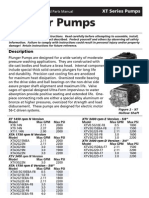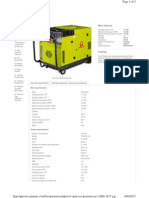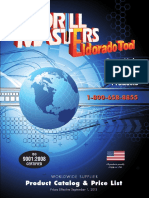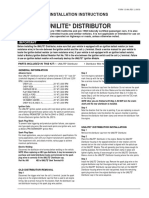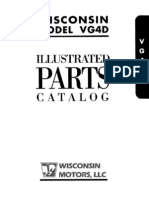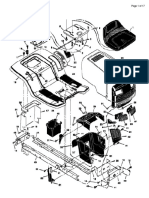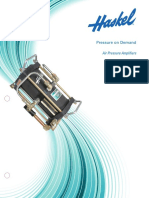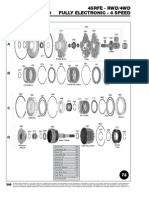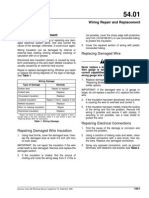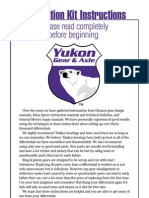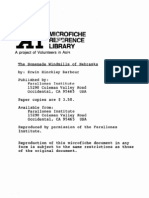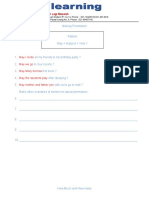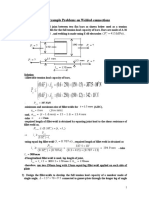Nissan
Nissan
Uploaded by
Ubaldo SanchezCopyright:
Available Formats
Nissan
Nissan
Uploaded by
Ubaldo SanchezOriginal Description:
Original Title
Copyright
Available Formats
Share this document
Did you find this document useful?
Is this content inappropriate?
Copyright:
Available Formats
Nissan
Nissan
Uploaded by
Ubaldo SanchezCopyright:
Available Formats
FL-1
ENGINE
C
D
E
F
G
H
I
J
K
L
M
SECTION FL
A
FL
N
O
P
CONTENTS
FUEL SYSTEM
VQ
SERVICE INFORMATION ........................ .... 2
PREPARATION .............................................. ..... 2
Commercial Service Tool .................................... ......2
FUEL SYSTEM .................................................... 3
Checking Fuel Line ...................................................3
General Precaution ...................................................3
FUEL TANK .................................................... ..... 5
Component .......................................................... ......5
Removal and Installation ...........................................5
FUEL LEVEL SENSOR UNIT, FUEL FILTER
AND FUEL PUMP ASSEMBLY .........................10
Component .......................................................... .... 10
Removal and Installation ......................................... 10
SERVICE DATA AND SPECIFICATIONS
(SDS) ..................................................................12
Standard and Limit .............................................. .... 12
YD
SERVICE INFORMATION ........................ ...13
PREPARATION .................................................13
Special Service Tools ..............................................13
FUEL SYSTEM ..................................................14
Checking Fuel Line ..................................................14
General Precaution ..................................................14
FUEL FILTER ....................................................15
Component ..............................................................15
Removal and Installation ..................................... ....15
Air Bleeding .............................................................16
Draining Water from Fuel Filter ........................... ....16
FUEL TANK ......................................................17
Component ..............................................................17
Removal and Installation ..................................... ....17
FUEL LEVEL SENSOR UNIT ...........................22
Component ..............................................................22
Removal and Installation ..................................... ....22
SERVICE DATA AND SPECIFICATIONS
(SDS) .................................................................24
Standard and Limit ..................................................24
FL-2
< SERVICE INFORMATION >
[VQ]
PREPARATION
SERVICE INFORMATION
PREPARATION
Commercial Service Tool INFOID:0000000005444444
Tool name Description
Fuel tank lock ring wrench Removing and installing fuel tank lock ring
ZZA0122D
FUEL SYSTEM
FL-3
< SERVICE INFORMATION >
[VQ]
C
D
E
F
G
H
I
J
K
L
M
A
FL
N
P
O
FUEL SYSTEM
Checking Fuel Line INFOID:0000000005444445
Inspect fuel lines, fuel filler cap and fuel tank for improper attach-
ment, leaks, cracks, damage, loose connections, chafing or deterio-
ration.
If necessary, repair or replace damaged parts.
General Precaution INFOID:0000000005444446
WARNING:
When replacing fuel line parts, be sure to observe the following.
Put a CAUTION: FLAMMABLE sign in the workshop.
Be sure to work in a well-ventilated area and furnish workshop with a CO2 fire extinguisher.
Never smoke while servicing fuel system. Keep open flames and sparks away from the work area.
CAUTION:
Use gasoline required by the regulations for octane number. Refer to GI-5, "Precaution for Fuel".
Before removing fuel line parts, perform the following procedures:
- Put drained fuel in an explosion-proof container and put the lid on securely. Keep the container in
safe area.
- Release fuel pressure from the fuel lines. Refer to EC-79, "Fuel Pressure Check" (models for Austra-
lia) or EC-553, "Fuel Pressure Check" (models except for Australia).
- Disconnect the battery cable from the negative terminal.
Always replace O-rings and clamps with new ones.
Never kink or twist hoses when they are being installed.
Never tighten hose clamps excessively to avoid damaging hoses.
Tighten high-pressure rubber hose clamp so that clamp end
is 3 mm (0.12 in) (a) from hose end.
Tightening torque specifications are the same for all rubber
hose clamps.
Ensure that screw does not contact adjacent parts.
SMA803A
b : 28 mm (1.10 in)
Fuel hose tightening torque:
: 1.0 - 1.5 Nm (0.10 - 0.15 kg-m, 9 - 13 in-lb)
JPBIA1459ZZ
FL-4
< SERVICE INFORMATION >
[VQ]
FUEL SYSTEM
After connecting the fuel tube quick connectors, check the
quick connectors are secure.
Ensure that the connector and resin tube never contact any
adjacent parts.
After installing tubes, check there is no fuel leakage at con-
nections in the following steps.
- Apply fuel pressure to fuel lines with turning ignition switch
ON (with engine stopped). Then check for fuel leaks at con-
nections.
- Start the engine and rev it up and check for fuel leaks at con-
nections.
Use only a Genuine NISSAN fuel filler cap as a replacement. If
an incorrect fuel filler cap is used, the MIL may come on.
For servicing Evaporative Emission System parts, refer to
EC-41 (for Australia models) or EC-531 (except for Australia
models).
PBIC1268E
FUEL TANK
FL-5
< SERVICE INFORMATION >
[VQ]
C
D
E
F
G
H
I
J
K
L
M
A
FL
N
P
O
FUEL TANK
Component INFOID:0000000005444447
Removal and Installation INFOID:0000000005444448
REMOVAL
WARNING:
Be sure to read General Precautions when working on fuel system. Refer to FL-3, "General Precau-
tion".
Drain fuel from fuel tank if necessary.
Perform work on level place.
1. Open fuel filler lid.
2. Open the fuel filler cap and release the pressure inside fuel tank.
1. Fuel filler cap 2. Grommet 3. Fuel filler tube
4. Fuel filler hose 5. Vent hose 6. Fuel filler tube
7. EVAP tube 8. Fuel tank 9. Fuel tank band (front)
10. Fuel tank band (rear) 11. Fuel feed tube 12. Fuel filler hose
13. Vent hose
A. To engine B. To EVAP canister
PBIC3840E
FL-6
< SERVICE INFORMATION >
[VQ]
FUEL TANK
3. Check fuel level on level place. If fuel gauge indicates more than
the level shown in figure (full or almost full), drain fuel from fuel
tank until gauge indicates level as shown in the figure or below.
NOTE:
Because fuel will be spilled when removing fuel level sensor
unit, fuel filter and fuel pump assembly for the top of the fuel is
above the fuel level sensor unit, fuel filter and fuel pump assem-
bly installation surface.
As a guide, fuel level becomes the position as shown in the
figure or below when approximately 20 (4-3/8 lmp gal) of
fuel are drained from fuel tank.
In a case that fuel pump does not operate, perform the follow-
ing steps.
a. Insert hose of less than 15 mm (0.59 in) in diameter into fuel filler tube through fuel filler opening to draw
fuel from fuel filler tube.
b. Disconnect fuel filler hose from fuel filler tube.
c. Insert tube into fuel tank to draw fuel from fuel tank.
As a guide, fuel level becomes the position shown in figure or below when approximately 20 (17-5/8
lmp qt) of fuel are drained from full tank.
NOTE:
Adjusting fuel level is to prevent fuel from spilling, when fuel level sensor unit is removed.
4. Release the fuel pressure from fuel lines. Refer to EC-79, "Fuel Pressure Check" (for Australia models) or
EC-553, "Fuel Pressure Check" (except for Australia models).
5. Disconnect the battery cable from the negative terminal.
6. Disconnect fuel feed tube (C).
Disconnect quick connector of fuel feed tube as follows:
- Hold the sides of the connector, push in tubs and pull out the
tube.
- If the connector and the tube are stuck together, push and pull
several times until they start to move. Then disconnect them
by pulling.
CAUTION:
A : Harness connector
B : EVAP tube
D : Fuel filler hose
E : Vent hose
PBIC3631E
PBIC3841E
SFE562A
FUEL TANK
FL-7
< SERVICE INFORMATION >
[VQ]
C
D
E
F
G
H
I
J
K
L
M
A
FL
N
P
O
Quick connector can be disconnected when the tabs are
completely depressed. Never twist it more than neces-
sary.
Never use any tools to disconnect quick connector.
Keep resin tube away from heat. Be especially careful
when welding near the resin tube.
Prevent acid liquid such as battery electrolyte etc. from
getting on resin tube.
Never bend or twist resin tube during installation and
removal.
Never remove the remaining retainer on hard tube (or
equivalent) except when resin tube or retainer is replaced.
When resin tube or fuel level sensor unit is replaced, also
replace retainer with a new one. Replace same color
retainer as before replacing.
To keep clean the connecting portion and to avoid dam-
age and foreign materials, cover them completely with
plastic bags or something similar.
7. Using a transmission jack (A), support the bottom of fuel tank
(1).
CAUTION:
Support the position that fuel tank bands never engage.
8. Remove fuel tank bands, and lower the transmission jack care-
fully until harness connector (A), EVAP tube (B), fuel filler hose
(D) and vent hose (E) can be disconnected.
9. Disconnect harness connector, EVAP tube, fuel filler hose and
vent hose.
Retainer color : Green
SBIA0504E
PBIC0163E
PBIC3377E
C : Fuel feed tube
PBIC3841E
FL-8
< SERVICE INFORMATION >
[VQ]
FUEL TANK
10. Supporting with hands, lower transmission jack carefully, and remove fuel tank.
CAUTION:
Pay attention not to fall fuel tank.
Check that all connection points have been disconnected.
Confirm there is no interference with vehicle.
11. Remove fuel filler tubes, fuel filler hoses and vent hoses if necessary.
INSTALLATION
Note the following, and install in the reverse order of removal.
Surely clamp fuel hoses and insert hose to the length below.
Be sure hose clamp is not positioned on swelled area of fuel tube.
Position fuel filler hose clamp (2) between paint marking (B).
Position vent hose clamp (2) as shown in the figure.
Tighten fuel hose clamp so that the flange (A) of bolt head is on the
paint mark (B) on the band.
Fit mounting band pin to the vehicle side securely.
Before fixing the fuel tank, temporarily install the fuel filler tube.
CAUTION:
Use genuine fuel filler tube mounting bolts or equivalent. Check to tighten them to the specified
torque.
Connect quick connector as follows.
1. Check connection for damage and foreign materials.
Fuel filler hose : 35 mm (1.38 in)
The other hose : 25 mm (0.98 in)
1 : Fuel filler hose
3 : Fuel filler tube
A : Paint marking
PBIC4163E
1 : Vent hose
3 : Vent tube (part of fuel filler tube)
PBIC4162E
PBIC4058E
FUEL TANK
FL-9
< SERVICE INFORMATION >
[VQ]
C
D
E
F
G
H
I
J
K
L
M
A
FL
N
P
O
2. Align the connector with the tube, then insert connector straight into tube until a click is heard.
3. After connecting, check that the connection is secure by following the steps below.
Visually confirm that the two tabs are connected to connector.
Pull the tube and connector to check they are securely con-
nected.
INSPECTION AFTER INSTALLATION
Check there is no fuel leakage at connections in the following steps.
1. Turn ignition switch ON (with engine stopped), then check connections for leaks by applying fuel pres-
sure to fuel piping.
2. Start engine and rev it up and check there is no fuel leakage at connections.
PBIC1653E
FL-10
< SERVICE INFORMATION >
[VQ]
FUEL LEVEL SENSOR UNIT, FUEL FILTER AND FUEL PUMP ASSEMBLY
FUEL LEVEL SENSOR UNIT, FUEL FILTER AND FUEL PUMP ASSEMBLY
Component INFOID:0000000005444449
Refer to GI-9, "Component" for symbol marks in the figure.
Removal and Installation INFOID:0000000005444450
REMOVAL
WARNING:
Be sure to read General Precautions when working on fuel system. Refer to FL-3, "General Precau-
tion".
1. Remove fuel tank from the vehicle. Refer to FL-5.
2. Using a fuel tank lock ring wrench (commercial service tool),
remove the lock ring.
3. Remove fuel level sensor unit, fuel filter and fuel pump assembly.
CAUTION:
Never bend the float arm during removal.
Avoid impacts such as falling when handling components.
INSPECTION AFTER REMOVAL
Check fuel level sensor unit, fuel filter and fuel pump assembly is free from foreign materials. If any are found,
remove them.
INSTALLATION
1. Lock ring 2.
Fuel level sensor unit, fuel filter and
fuel pump assembly
3. Seal packing
4. Fuel tank
A. Refer to text.
PBIC3842E
PBIC0240E
FUEL LEVEL SENSOR UNIT, FUEL FILTER AND FUEL PUMP ASSEMBLY
FL-11
< SERVICE INFORMATION >
[VQ]
C
D
E
F
G
H
I
J
K
L
M
A
FL
N
P
O
Note the following, and install in the reverse order of removal.
1. Install fuel level sensor unit, fuel filter and fuel pump assembly
(1) with aligning mating marks (A) on fuel tank and fuel level
sensor unit, fuel filter and fuel pump assembly as shown in the
figure.
2. Install lock ring (1).
a. Tighten lock ring by hand.
b. Tighten lock ring with a fuel tank lock ring wrench (commercial
service tool).
c. Align mating marks (A) as shown in the figure.
INSPECTION AFTER INSTALLATION
Check there is no fuel leakage at connections in the following steps.
Turn ignition switch ON (with engine stopped), then check connections for leaks by applying fuel pressure
to fuel piping.
Start engine and rev it up and check there is no fuel leakage at the fuel system connections.
: Vehicle front
PBIC3843E
: Vehicle front
PBIC3632E
FL-12
< SERVICE INFORMATION >
[VQ]
SERVICE DATA AND SPECIFICATIONS (SDS)
SERVICE DATA AND SPECIFICATIONS (SDS)
Standard and Limit INFOID:0000000005444451
Fuel tank capacity Approx. 80 (17-5/8 Imp gal)
Fuel recommendation Refer to GI-5.
PREPARATION
FL-13
< SERVICE INFORMATION >
[YD]
C
D
E
F
G
H
I
J
K
L
M
A
FL
N
P
O
SERVICE INFORMATION
PREPARATION
Special Service Tools INFOID:0000000006109097
Tool number
Tool name
Description
KV991-04'700
Lock ring wrench
Removing and Installing lock ring
ZZA0122D
FL-14
< SERVICE INFORMATION >
[YD]
FUEL SYSTEM
FUEL SYSTEM
Checking Fuel Line INFOID:0000000006109098
Inspect fuel lines, fuel filler cap and fuel tank for improper attach-
ment, leaks, cracks, damage, loose connections, chafing or deterio-
ration.
If necessary, repair or replace damaged parts.
General Precaution INFOID:0000000006109099
WARNING:
When replacing fuel line parts, be sure to observe the following.
Put a CAUTION: FLAMMABLE sign in workshop.
Be sure to work in a well-ventilated area and furnish workshop with a CO2 fire extinguisher.
Never smoke while servicing fuel system. Keep open flames and spark away from work area.
CAUTION:
Use diesel fuel required by the regulations for cetane number. Refer to GI-5.
Before removing fuel line parts, perform the following procedures:
- Put drained fuel in an explosion-proof container and put the lid on securely. Keep the container in
safe area.
- Disconnect the battery cable from the negative terminal.
Always replace O-ring and clamps with new ones.
Never kink or twist tubes when they are being installed.
Never tighten hose clamps excessively to avoid damaging hoses.
After connecting fuel tube quick connectors, check quick con-
nectors are secure.
Ensure that connector and resin tube never contact any adja-
cent parts.
After installing tubes, check there is no fuel leakage at con-
nections in the following steps.
- Start the engine and rev it up and check for fuel leaks at con-
nections.
SMA803A
SBIA0504E
FUEL FILTER
FL-15
< SERVICE INFORMATION >
[YD]
C
D
E
F
G
H
I
J
K
L
M
A
FL
N
P
O
FUEL FILTER
Component INFOID:0000000006109100
Refer to GI-9 for symbol marks in the figure.
Removal and Installation INFOID:0000000006109101
REMOVAL
1. Disconnect fuel hoses.
CAUTION:
Plug the pipe to prevent fuel from draining.
2. Remove fuel filter assembly from bracket.
CAUTION:
Never splash fuel during removal. If fuel is splashed, immediately wipe it off.
INSTALLATION
Note the following, and install in the reverse order of removal.
Install fuel filter (1), and tighten mounting nuts (2) to the specified
torque.
1. Bracket 2. Bracket 3. Fuel filter assembly
4. Fuel hose 5. Priming pump
A. To fuel tube B. To centralized under-floor piping
MBIB1590E
3 : Mounting bolt
4 : Priming pump
: Vehicle front
Fuel filter mounting nuts
: 13.5 Nm (1.4 kg-m, 10 ft-lb)
PBIC4861E
FL-16
< SERVICE INFORMATION >
[YD]
FUEL FILTER
When assembling fuel filter assembly and bracket, adjust the angle
of fuel filter assembly as shown in the figure.
After installation, bleed air from fuel line. Refer to FL-16, "Air
Bleeding".
INSPECTION AFTER INSTALLATION
Check there is no fuel leakage at connections in the following steps.
Start the engine and rev it up and check there is no fuel leakage at connections.
Air Bleeding INFOID:0000000006109102
After fuel filter is replaced and after fuel system components are removed/installed, bleed air from fuel line as
follows:
1. Prime the circuit using the priming pump (1).
2. Perform engine cranking with repeating several times until
engine starting.
NOTE:
If engine does not start, stop cranking and repeat step 1
above.
If engine does not operate smoothly after it has started, race it
two or three times.
CAUTION:
Crank engine until it starts. Never crank engine for more
than 30 seconds.
Draining Water from Fuel Filter INFOID:0000000006109103
1. Connect drain hose (suitable hose) to the end of drain plug (A).
2. Prepare a tray at the drain plug open end.
3. Loosen drain plug, and operate priming pump to drain water
from fuel filter.
CAUTION:
Water in filter is drained with fuel. Prepare larger capacity
pan than fuel filter volume.
Drained water is mixed with fuel. Prevent fuel from adher-
ing to rubber parts such as engine mounting insulator.
4. After draining, close drain plug by hand.
CAUTION:
If drain plug is tightened excessively, it may be damaged
and fuel will leak. Never use tools to tighten drain plug.
5. Bleed air in fuel piping. Refer to FL-16, "Air Bleeding".
6. Start engine and check there is no fuel leakage.
A : Drain plug
MBIB1591E
PBIC4860E
MBIB1593E
FUEL TANK
FL-17
< SERVICE INFORMATION >
[YD]
C
D
E
F
G
H
I
J
K
L
M
A
FL
N
P
O
FUEL TANK
Component INFOID:0000000006109104
Removal and Installation INFOID:0000000006109105
REMOVAL
WARNING:
Be sure to read General Precautions when working on fuel system. Refer to GI-3.
1. Open fuel filler lid.
2. Open the fuel filler cap and release the pressure inside fuel tank.
1. Fuel filler cap 2. Grommet 3. Fuel filler tube
4. Fuel filler hose 5. Vent hose 6. Fuel filler tube
7. EVAP tube 8. EVAP tube 9. Fuel tank
10. Fuel tank band (front) 11. Fuel tank band (rear) 12. Fuel feed tube
13. Fuel return tube 14. Fuel filler hose 15. Vent hose
A. To fuel filter B. To engine
E1BIA0266GB
FL-18
< SERVICE INFORMATION >
[YD]
FUEL TANK
3. Check fuel level on level place. If fuel gauge indicates more than
the level shown in figure (full or almost full), drain fuel from fuel
tank until gauge indicates level as shown in the figure or below.
NOTE:
Because fuel will be spilled when removing fuel level sensor unit
for the top of the fuel is above fuel level sensor unit installation
surface.
As a guide, fuel level becomes the position as shown in the
figure or below when approximately 20 (4-3/8 lmp gal) of
fuel are drained from fuel tank.
Refer to the following for draining fuel.
a. Insert fuel tube of less than 15 mm (0.59 in) in diameter into fuel
filler tube through fuel filler opening to draw fuel from fuel filler tube.
b. Disconnect fuel filler hose from fuel filler tube.
c. Insert fuel tube into fuel tank through fuel filler hose to draw fuel from fuel tank.
NOTE:
Adjusting fuel level is to prevent fuel from spilling, when fuel level sensor unit is removed.
4. Disconnect the battery cable from the negative terminal.
5. Disconnect fuel feed tube (C) and fuel return tube (D).
Disconnect quick connector of fuel feed tube and fuel return tube as follows.
- Hold the sides of the connector, push in tubs and pull out the
tube.
- If the connector and the tube are stuck together, push and pull
several times until they start to move. Then disconnect them
by pulling.
CAUTION:
A : Harness connector
B : EVAP tube
E : Fuel filler hose
F : Vent hose
PBIC3631E
PBIC3375E
SFE562A
FUEL TANK
FL-19
< SERVICE INFORMATION >
[YD]
C
D
E
F
G
H
I
J
K
L
M
A
FL
N
P
O
Quick connector can be disconnected when the tabs are
completely depressed. Never twist it more than neces-
sary.
Never use any tools to disconnect quick connector.
Keep resin tube away from heat. Be especially careful
when welding near the resin tube.
Prevent acid liquid such as battery electrolyte etc. from
getting on resin tube.
Never bend or twist resin tube during installation and
removal.
Never remove the remaining retainer on hard tube (or
equivalent) except when resin tube or retainer is
replaced.
When resin tube or fuel level sensor unit is replaced,
also replace retainer with a new one. Replace same
color retainer as before replacing.
To keep clean the connecting portion and to avoid dam-
age and foreign materials, cover them completely with
plastic bags or something similar.
6. Using a transmission jack (A), support the bottom of fuel tank
(1).
CAUTION:
Support the position that fuel tank bands never engage.
7. Remove fuel tank bands, and lower the transmission jack care-
fully until harness connector (A), EVAP tube (B), fuel filler hose
(E) and vent hose (F) can be disconnected.
8. Disconnect harness connector, EVAP tube, fuel filler hose and
vent hose.
Retainer color : Green (Fuel feed tube)
: Gray (Fuel return tube)
SBIA0504E
PBIC0163E
PBIC3377E
C : Fuel feed tube
D : Fuel return tube
PBIC3375E
FL-20
< SERVICE INFORMATION >
[YD]
FUEL TANK
9. Supporting with hands, lower transmission jack carefully, and remove fuel tank.
CAUTION:
Pay attention not to fall fuel tank.
Check that all connection points have been disconnected.
Confirm there is no interference with vehicle.
10. Remove fuel filler tubes, fuel filler hoses and vent hoses if necessary.
INSTALLATION
Note the following, and install in the reverse order of removal.
Surely clamp fuel hoses and insert hose to the length below.
Be sure hose clamp is not positioned on swelled area of fuel tube.
Position fuel filler hose clamp (2) between paint marking (B).
Position vent hose clamp (2) as shown in the figure.
Tighten fuel hose clamp so that the flange (A) of bolt head is on the
paint mark (B) on the band.
Fit mounting band pin to the vehicle side securely.
Before fixing the fuel tank, temporarily install the fuel filler tube.
CAUTION:
Use genuine fuel filler tube mounting bolts or equivalent. Check to tighten them to the specified
torque.
Connect quick connector as follows.
1. Check connection for damage and foreign materials.
2. Align the connector with the tube, then insert connector straight into tube until a click is heard.
Fuel filler hose : 35 mm (1.38 in)
The other hose : 25 mm (0.98 in)
1 : Fuel filler hose
3 : Fuel filler tube
A : paint marking
PBIC4163E
1 : Vent hose
3 : Vent tube (part of fuel filler tube)
PBIC4162E
PBIC4058E
FUEL TANK
FL-21
< SERVICE INFORMATION >
[YD]
C
D
E
F
G
H
I
J
K
L
M
A
FL
N
P
O
3. After connecting, check that the connection is secure by following the steps below.
Visually confirm that the two tabs are connected to connector.
Pull the tube and connector to check they are securely con-
nected.
INSPECTION AFTER INSTALLATION
Check there is no fuel leakage at connections in the following step.
Start engine and rev it up and check there is no fuel leakage at connections.
PBIC1653E
FL-22
< SERVICE INFORMATION >
[YD]
FUEL LEVEL SENSOR UNIT
FUEL LEVEL SENSOR UNIT
Component INFOID:0000000006109106
Refer to GI-9 for symbol marks in the figure.
Removal and Installation INFOID:0000000006109107
REMOVAL
WARNING:
Be sure to read General Precautions when working on fuel system. Refer to FL-14, "General Precau-
tion".
1. Remove fuel tank from the vehicle. Refer to FL-17.
2. Using a fuel tank lock ring wrench to remove the lock ring. Refer
to FL-13, "Special Service Tools"
3. Remove fuel level sensor unit.
CAUTION:
Never bend the float arm during removal.
Avoid impacts such as falling when handling components.
INSPECTION AFTER REMOVAL
Check fuel level sensor unit is free from foreign materials. If any are found, remove them.
INSTALLATION
Note the following, and install in the reverse order of removal.
1. Lock ring 2. Fuel level sensor unit 3. Seal packing
4. Fuel tank
A. Refer to text.
PBIC3374E
PBIC0240E
FUEL LEVEL SENSOR UNIT
FL-23
< SERVICE INFORMATION >
[YD]
C
D
E
F
G
H
I
J
K
L
M
A
FL
N
P
O
1. Install fuel level sensor unit (1) with aligning mating marks (A) on
fuel tank and fuel level sensor unit as shown in the figure.
2. Install lock ring (1).
a. Tighten lock ring by hand.
b. Tighten lock ring with a fuel tank lock ring wrench. Refer to FL-
13, "Special Service Tools"
c. Aligning mating marks (A) on fuel tank and lock ring as shown in
the figure.
INSPECTION AFTER INSTALLATION
Check there is no fuel leakage at connections in the following steps.
Start engine and rev it up and check there is no fuel leakage at connections.
: Vehicle front
PBIC3506E
: Vehicle front
PBIC3632E
FL-24
< SERVICE INFORMATION >
[YD]
SERVICE DATA AND SPECIFICATIONS (SDS)
SERVICE DATA AND SPECIFICATIONS (SDS)
Standard and Limit INFOID:0000000006109108
Fuel tank capacity Approx. 80 (17-5/8 Imp gal)
Fuel recommendation Refer to MA-18
You might also like
- 2023 Burn Rate ChartDocument1 page2023 Burn Rate ChartRandyWilson0% (1)
- 2003 Nissan Altima 2.5 Serivce Manual FLDocument10 pages2003 Nissan Altima 2.5 Serivce Manual FLAndy DellingerNo ratings yet
- Mercedes-Benz UNIMOG Overview (1953-1962) © WWW - Mbzponton - OrgDocument5 pagesMercedes-Benz UNIMOG Overview (1953-1962) © WWW - Mbzponton - OrgBill KobinNo ratings yet
- 008-014 Coolant Thermostat HousingDocument3 pages008-014 Coolant Thermostat HousingYè WințNo ratings yet
- Johnson Outboard Ignition SwitchDocument2 pagesJohnson Outboard Ignition SwitchJSMarine Parts ChinaNo ratings yet
- Ingersoll Rand Compressor - 2475 Engineering Data SheetsDocument2 pagesIngersoll Rand Compressor - 2475 Engineering Data SheetsJNo ratings yet
- 360 - 460 - 510 Series Tractors: Service ManualDocument210 pages360 - 460 - 510 Series Tractors: Service ManualNicusor BuleteanuNo ratings yet
- 500ASDocument4 pages500ASibnu malkanNo ratings yet
- Operator'S Manual Manuel de L'Utilisateur Manual Del OperadorDocument25 pagesOperator'S Manual Manuel de L'Utilisateur Manual Del OperadorSergio LopezNo ratings yet
- Annovi Reverberi XTV-2.1 Operating & Parts ManualDocument18 pagesAnnovi Reverberi XTV-2.1 Operating & Parts Manualinscribe100% (1)
- Single Phase P11000 (Yanmar)Document2 pagesSingle Phase P11000 (Yanmar)gigo_dreamNo ratings yet
- Ydp 20 MHDocument1 pageYdp 20 MHTaufiq Omar HasanNo ratings yet
- Manual Liqmax II 240Document31 pagesManual Liqmax II 240Elros RomeoNo ratings yet
- ARB 3438100 FittingDocument7 pagesARB 3438100 FittingthailanNo ratings yet
- Photos by Author October/November2001Document1 pagePhotos by Author October/November2001angel123No ratings yet
- Dme CatalogDocument28 pagesDme Cataloggalici2002No ratings yet
- Bridgeport Rebuid 2Document15 pagesBridgeport Rebuid 2wolviak100% (1)
- Gear Making: Workshop Practice ME-105Document14 pagesGear Making: Workshop Practice ME-105Mazahir habibNo ratings yet
- Nissan Frontier Factory Service ManualDocument50 pagesNissan Frontier Factory Service ManualMilton Alpizar100% (3)
- Catalogo Lincoln 2009 PDFDocument174 pagesCatalogo Lincoln 2009 PDFBenavides EdissonNo ratings yet
- Mallory Instructions Unilite Distributor 37 38 45 47Document12 pagesMallory Instructions Unilite Distributor 37 38 45 47teoma34No ratings yet
- Screw Thread Cutt Book-N° 32 PDFDocument41 pagesScrew Thread Cutt Book-N° 32 PDFDamian100% (1)
- 118 014 YA5550 Snap On 55 Amp PlasmDocument4 pages118 014 YA5550 Snap On 55 Amp PlasmStuartBohm0% (1)
- Yz 250 F-2006Document69 pagesYz 250 F-2006AdolfoNo ratings yet
- Ford Engines CatalogDocument18 pagesFord Engines CatalogAngel Quiroga100% (1)
- Definition of Synchromesh Gear BoxDocument13 pagesDefinition of Synchromesh Gear BoxAmol Rasane100% (1)
- VG4D PartsDocument43 pagesVG4D Partsdschwab87No ratings yet
- Ferris IS2000ZDocument96 pagesFerris IS2000ZYew LimNo ratings yet
- Murray Model 42560x92a Lawn Tractor (1997) Parts ListDocument17 pagesMurray Model 42560x92a Lawn Tractor (1997) Parts ListJared ButalaNo ratings yet
- Machinery: Making World-Famous Automatic PistolDocument14 pagesMachinery: Making World-Famous Automatic PistolJesus Cortez100% (3)
- 722.4x Black Modulator ValveDocument6 pages722.4x Black Modulator ValveOscar ChohfiNo ratings yet
- Nissan Ign Nostart Pathfinder 1996 2000Document31 pagesNissan Ign Nostart Pathfinder 1996 2000Misael AmayaNo ratings yet
- 1977 Jeep-1977 TSBDocument126 pages1977 Jeep-1977 TSBperzaklieNo ratings yet
- Opera Ting Manual: HQ400/3A - HQ400/3B - HQ400/3L Multi - Purpose MachineDocument34 pagesOpera Ting Manual: HQ400/3A - HQ400/3B - HQ400/3L Multi - Purpose MachinerianrureNo ratings yet
- Haskel Air AaDocument12 pagesHaskel Air AaJorge CastilloNo ratings yet
- 45RFEDocument6 pages45RFEfloo1975No ratings yet
- Golf TDi 2.0Document162 pagesGolf TDi 2.0kilofome05No ratings yet
- Vanguard Twin Cylinder OHVDocument191 pagesVanguard Twin Cylinder OHVEdward Baxter-bath100% (4)
- Ac Catalog Compressor Parts 2010Document19 pagesAc Catalog Compressor Parts 2010edgardo tovarNo ratings yet
- Variable Camshaft Timing - Variable Valve TimingDocument85 pagesVariable Camshaft Timing - Variable Valve TiminglibertyplusNo ratings yet
- Operator's Manual: Mercedes-BenzDocument137 pagesOperator's Manual: Mercedes-Benzrazvan33No ratings yet
- Service Manual Welder Machine Air Vantage 600-IDocument65 pagesService Manual Welder Machine Air Vantage 600-IDercio CostaNo ratings yet
- Wiring Repair and Replacement PDFDocument10 pagesWiring Repair and Replacement PDFCesar Bayes Ramos0% (2)
- A Ball MillDocument5 pagesA Ball Millgy0rgy0murvai0% (1)
- 1999 Dodge CodesDocument23 pages1999 Dodge CodesNoel Spangenburg100% (1)
- Thermal Arc 161 STL 201 Ts Inverter Welder SM PDFDocument96 pagesThermal Arc 161 STL 201 Ts Inverter Welder SM PDFduy100% (1)
- Yukon Dana Ring & Pinion InstallationDocument16 pagesYukon Dana Ring & Pinion InstallationCAP History Library100% (13)
- The Homemade Windmills of Nebraska (1899)Document79 pagesThe Homemade Windmills of Nebraska (1899)Stathis Kiousis100% (1)
- Remove Head IsmDocument67 pagesRemove Head IsmjeremyNo ratings yet
- Maintenance Manual Front AxleDocument65 pagesMaintenance Manual Front Axlehebert perezNo ratings yet
- Specs CASE 821E SeriesDocument6 pagesSpecs CASE 821E SeriesDian SikumbangNo ratings yet
- Hardwood Sound Clock Parts CatalogDocument136 pagesHardwood Sound Clock Parts CatalogRonald Capodagli100% (1)
- YD 25 Engines IssuesDocument4 pagesYD 25 Engines IssuesZauron Kent TouchitNo ratings yet
- Rebuilding Nippon Denso Alternator 00-01 A - JeepForumDocument14 pagesRebuilding Nippon Denso Alternator 00-01 A - JeepForumejen_glNo ratings yet
- Millermatic 250x ManualDocument40 pagesMillermatic 250x ManualEduardo Mata GamezNo ratings yet
- Ford Old TimersDocument25 pagesFord Old TimersJan-Erik Kaald HusbyNo ratings yet
- Engine Valve DesignsDocument6 pagesEngine Valve DesignsGhanvir SinghNo ratings yet
- Fuel System: SectionDocument15 pagesFuel System: SectionRonildo GirardiNo ratings yet
- 2008 Nissan Teana J32 Service Manual-FLDocument11 pages2008 Nissan Teana J32 Service Manual-FLMrihexNo ratings yet
- Fuel System: SectionDocument18 pagesFuel System: SectionMihai IavorschiNo ratings yet
- Fuel System: SectionDocument10 pagesFuel System: SectiontsudsingNo ratings yet
- Working FileDocument120 pagesWorking FileajayNo ratings yet
- Host ScriptDocument4 pagesHost Scriptmarsnowhite60064No ratings yet
- Hobbies Questionnaire ResultsDocument9 pagesHobbies Questionnaire ResultsEllie WilliamsNo ratings yet
- Backhoe Loader 310J: EngineDocument5 pagesBackhoe Loader 310J: EngineEnzo Miguel Sarabia MontesNo ratings yet
- 2019 INTRAMURAL MEET - Docx fiNALDocument3 pages2019 INTRAMURAL MEET - Docx fiNALBlurry GreyNo ratings yet
- Sim Jia Zheng 5L1TESTIMONIAL 2012 EdrtDocument4 pagesSim Jia Zheng 5L1TESTIMONIAL 2012 EdrtBernard GohNo ratings yet
- Wellness Worksheet2Document4 pagesWellness Worksheet2kr7263No ratings yet
- Samarpan Academy: Airforce Y Group Practice SetDocument14 pagesSamarpan Academy: Airforce Y Group Practice Setnegisumit465No ratings yet
- Gugong Quick Summary v1.2Document6 pagesGugong Quick Summary v1.2Randolf BluedragonNo ratings yet
- Worksheet 3.2Document8 pagesWorksheet 3.2SD Elearing AcademyNo ratings yet
- Phasma Hidden AbilitisDocument6 pagesPhasma Hidden AbilitisMarek RigoNo ratings yet
- CODEX - ADEPTUS CUSTODES v1-2Document2 pagesCODEX - ADEPTUS CUSTODES v1-2Vincent DargirolleNo ratings yet
- Present Continuous-Guia de Ejercicios COMPLETADocument6 pagesPresent Continuous-Guia de Ejercicios COMPLETAAnonymous mwcN0Yi7No ratings yet
- 2008.75 MY (Model Year) Ford Vehicle Diagnostic Report - MNBJXXARJJCE28390 - 2023089212025Document3 pages2008.75 MY (Model Year) Ford Vehicle Diagnostic Report - MNBJXXARJJCE28390 - 2023089212025Yogas Asa Wara BangunNo ratings yet
- N A F A F P: Example Problems On Welded-ConnectionsDocument8 pagesN A F A F P: Example Problems On Welded-ConnectionsEng Abdikarim WalhadNo ratings yet
- Ander LackmanDocument6 pagesAnder Lackmandj BattlecryNo ratings yet
- Special TestDocument12 pagesSpecial TestSIMPLEJGNo ratings yet
- Level 3 - Kevin Brophy - Manchester UnitedDocument26 pagesLevel 3 - Kevin Brophy - Manchester UnitedKecskes Dani ErikaNo ratings yet
- WinGD EngineDataDocument33 pagesWinGD EngineDataael oleNo ratings yet
- WILDERFEAST - Quickstart 1.5 (01-20)Document20 pagesWILDERFEAST - Quickstart 1.5 (01-20)kauandb80No ratings yet
- Mitsubishi Xpander ASEAN NCAPDocument4 pagesMitsubishi Xpander ASEAN NCAPcarbasemyNo ratings yet
- Women World Cup 2022Document4 pagesWomen World Cup 2022swapnadip99No ratings yet
- How To Succeed Ebook PDFDocument41 pagesHow To Succeed Ebook PDFregistermail100% (4)
- Catalog Arnott IndustriesDocument36 pagesCatalog Arnott IndustriesKhaled HalouaneNo ratings yet
- 150 BigDocument51 pages150 BigMieczysław MichalczewskiNo ratings yet
- Test Schedule-Pre Uni Plus 1st Year 22-23Document2 pagesTest Schedule-Pre Uni Plus 1st Year 22-23MOUSE 123WNo ratings yet
- Pancake Day Great A, Little A, This Is Pancake Day Toss The Ball High, Throw The Ball Low, Those That Come After May Sing Heigh-Ho!Document4 pagesPancake Day Great A, Little A, This Is Pancake Day Toss The Ball High, Throw The Ball Low, Those That Come After May Sing Heigh-Ho!Donnette DavisNo ratings yet
- Auto Express UK - 2023.03.08Document84 pagesAuto Express UK - 2023.03.08Diogo Henrique RamôaNo ratings yet
- IPS Parts Catalogue June 2016Document52 pagesIPS Parts Catalogue June 2016ashielanieNo ratings yet









